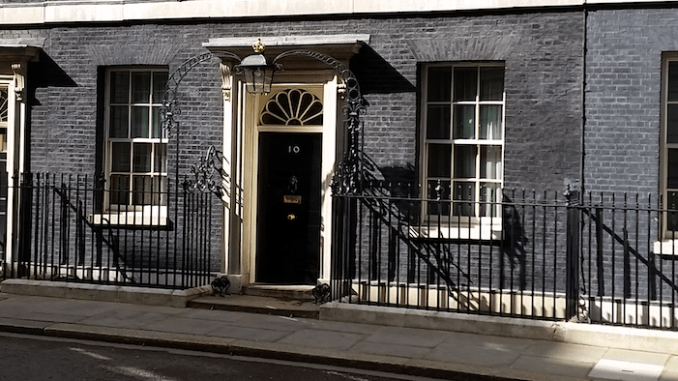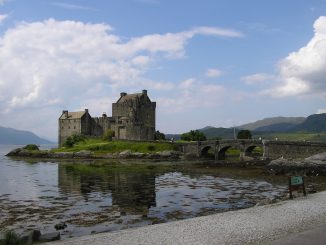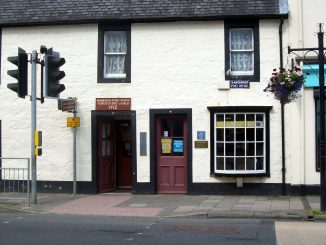
10 Downing Street, commonly just called Number 10 (or No. 10) throughout the United Kingdom, is the headquarters of the Government of the United Kingdom and the official residence of the First Lord of the Treasury, a post that since 1905 has been held by the Prime Minister. Despite the simple entrance known around the world for it’s black door with a white 10 on it, No. 10 is much more than a single residence. It’s actually a combination of 300+ years of British history, wrapped up in multiple combined buildings with approximately 100 rooms. Originally three buildings, No. 10 was offered as a gift by King George II in 1732 to Sir Robert Walpole who graciously accepted on the condition that the gift went instead to the office of First Lord of the Treasury.
Sir George Downing, a notorious spy, invested in property and acquired considerable wealth. In 1654, he purchased a lease on land south of St James’s Park, within walking distance of parliament. Downing planned to build a row of terraced town houses “for persons of good quality”. The street now bears his name. Downing himself however never lived on Downing Street. In 1675 he retired to Cambridge, where he died in 1684. As per his wishes, the wealth he had accumulated was used to found Downing College, Cambridge. His portrait hangs in the entrance hall of Number 10.
Number 10 was built on soft soil and had a fairly shallow foundation, making it prone to shifting and somewhat unsafe place to live. For this reason, and its comparatively diminutive size, many early First Lords chose not to live there. They instead chose to remain at their more stately private homes and allow foreign dignitaries or family members to occupy the house.
Number 10’s well recognized door is the result of the renovations ordered by Charles Townshend in 1766. Probably not completed until 1772. The small, six-paneled door, originally made of black oak. Painted in white, between the top and middle sets of panels, is the number “10”. The zero of the number “10” is painted in a very eccentric style, in a 37° angle. A black iron knocker in the shape of a lion’s head rests between the two middle panels just above a brass letter box with the inscription “First Lord of the Treasury”.
Because the building was in such a state of disrepair, it was either completely vacant of used exclusively for offices from 1834 to 1877. It was not just No. 10 that fell onto hard times around the turn of the 19th century though. The rest of Downing Street was likewise dilapidated and the dark alleys were a perfect place for both criminals and for ladies of the night to practice their respective crafts.
During the middle of the 20th century it was decided that the building had become such an important part of the government that a complete restoration needed to be undertaken. The foundation was replaced and steel deep pilings were used to prevent it from ever sinking or shifting again. The building was restored to look much the same as it always had but it was modernized to make it a comfortable as well as functional space. During this renovation builders discovered that the dark exterior façade seen in photographs dating back to the mid-19th century was a result of pollution and soot. The external brick was originally a soft yellow and is not painted black to preserve the traditional look familiar around the world.
The private residence occupies the third floor and there is a kitchen in the basement. The other floors consist of offices, conference rooms, sitting rooms, and a large dining room where the Prime Minister may host world leaders and foreign dignitaries. 10 Downing Street currently houses the UK Cabinet Room in which Cabinet meetings take place, and the Prime Minister’s executive office.
No. 10 Downing Street Facts
- The front door cannot be opened from the outside, and there is always someone inside to unlock the door.
- Number 10 is over 300 years old and contains approximately 100 rooms.
- Margaret Thatcher said Number 10 had become “one of the most precious jewels in the national heritage”.
- No. 10 features an interior courtyard and a terrace overlooking a 0.5 acres (2,000 m2) garden.
- The addresses on Downing Street changed several times, and in 1787 Number 5 became Number 10.
- William Pitt the Younger made it his home for twenty years (longer than any First Lord before or since), from 1783 to 1801 and again from 1804 to 1806.
- During renovations as many as 40 coats of paint were stripped from the elaborate cornices in the main rooms revealing details unseen in some cases for almost 200 years.
- Carved into the plaster work above the door leading to the Pillared Room is a straw-carrying thatcher that serves as a tribute to Margaret Thatcher.
- The Metropolitan Police Service’s Diplomatic Protection Group (DPG) provides overall protection and acts on intelligence from MI5.
- No. 10 Downing Street has a lift.
Tenants of 10 Downing Street
- Prime Minister of the United Kingdom (First Lord of the Treasury).
- Prime Minister’s Family.
- Chief Mouser to the Cabinet Office.



